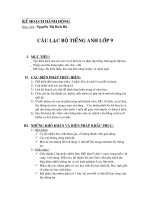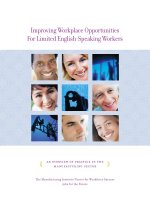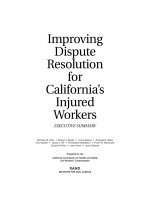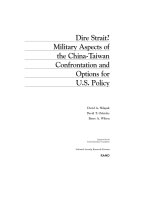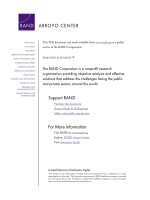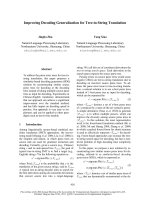Improving Dispute Resolution for California’s Injured Workers doc
Bạn đang xem bản rút gọn của tài liệu. Xem và tải ngay bản đầy đủ của tài liệu tại đây (138.12 KB, 31 trang )
Nicholas M. Pace • Robert T. Reville • Lionel Galway • Amanda B. Geller
Orla Hayden • Laural A. Hill • Christopher Mardesich • Frank W. Neuhauser
Suzanne Polich • Jane Yeom • Laura Zakaras
Prepared for the
California Commission on Health and Safety
and Workers’ Compensation
Improving
Dispute
Resolution
for
California’s
Injured
Workers
EXECUTIVE SUMMARY
R
INSTITUTE FOR CIVIL JUSTICE
The research described in this report was prepared for the California
Commission on Health and Safety and Workers’ Compensation. This
research was conducted by the RAND Institute for Civil Justice.
RAND is a nonprofit institution that helps improve policy and
decisionmaking through research and analysis. RAND
®
is a
registered trademark. RAND’s publications do not necessarily reflect
the opinions or policies of its research sponsors.
© Copyright 2003 RAND
All rights reserved. No part of this book may be reproduced in any
form by any electronic or mechanical means (including
photocopying, recording, or information storage and retrieval)
without permission in writing from RAND.
Published 2003 by RAND
1700 Main Street, P.O. Box 2138, Santa Monica, CA 90407-2138
1200 South Hayes Street, Arlington, VA 22202-5050
201 North Craig Street, Suite 202, Pittsburgh, PA 15213
RAND URL: />To order RAND documents or to obtain additional information,
contact Distribution Services: Telephone: (310) 451-7002;
Fax: (310) 451-6915; Email:
Library of Congress Cataloging-in-Publication Data
Improving dispute resolution for California’s injured workers /
Nicholas M. Pace [et al.]
p. cm.
“MR-1425.”
Includes bibliographical references.
ISBN 0-8330-3276-3 (pbk.)
1. California. Workers’ Compensation Appeals Board—Rules and practice. 2.
Workers’ compensation claims—California. 3. Workers’ compensation—Law and
legislation—California. I. Pace, Nicholas M. (Nicholas Michael), 1955–
KFC592.2 .I47 2003
344.794'021—dc21
2002156096
“MR-1425/1.”
ISBN 0-8330-3348-4
iii
THE INSTITUTE FOR CIVIL JUSTICE
The mission of the RAND Institute for Civil Justice (ICJ) is to improve
private and public decisionmaking on civil legal issues by supplying
policymakers and the public with the results of objective, empirically
based, analytic research. The ICJ facilitates change in the civil justice
system by analyzing trends and outcomes, identifying and evaluating
policy options, and bringing together representatives of different in-
terests to debate alternative solutions to policy problems. The Insti-
tute builds on a long tradition of RAND research characterized by an
interdisciplinary, empirical approach to public policy issues and rig-
orous standards of quality, objectivity, and independence.
ICJ research is supported by pooled grants from corporations, trade
and professional associations, and individuals; by government grants
and contracts; and by private foundations. The Institute dissemi-
nates its work widely to the legal, business, and research communi-
ties, and to the general public. In accordance with RAND policy, all
Institute research products are subject to peer review before publi-
cation. ICJ publications do not necessarily reflect the opinions or
policies of the research sponsors or of the ICJ Board of Overseers.
For additional information about the Institute for Civil Justice,
contact:
Robert T. Reville, Director
RAND Institute for Civil Justice
1700 Main Street, P.O. Box 2138
Santa Monica, CA 90407-2138
Phone: (310) 393-0411 x6786; Fax: (310) 451-6979
E-mail: ; Web: www.rand.org/icj/
v
CALIFORNIA COMMISSION ON HEALTH AND SAFETY
AND WORKERS’ COMPENSATION
EMPLOYER MEMBERS
Jill Dulich, Regional Director, Marriott International,
Appointed by Governor
Kristen Schwenkmeyer, Secretary-Treasurer, Gordon &
Schwenkmeyer, Appointed by Senate
Robert B. Steinberg, Esq., Sr. Partner, Rose, Klein & Marias,
Appointed by Assembly
John Wilson (retired), Schools Excess Liability Fund,
Appointed by Governor
LABOR MEMBERS
Allen Davenport, Director of Government Relations, S.E.I.U.
California State Council, Appointed by Speaker of the Assembly
Leonard McLeod, Finance Chair, California Correctional Peace
Officers Association, Appointed by Governor
Tom Rankin, President, California Labor Federation,
Appointed by Senate
Darrel (Shorty) Thacker, Central District Manager, Northern
California, Council of Carpenters, Appointed by Governor
EXECUTIVE OFFICER
Christine Baker
vii
PREFACE
For more than two decades, legislators, stakeholders, and litigants
have complained that the process by which disputed workers’ com-
pensation claims in California are adjudicated and resolved has be-
come ponderously slow, too expensive, and plagued by a lack of
consistency from office to office, from judge to judge, and from case
to case. In response to these concerns, the Commission on Health
and Safety and Workers’ Compensation (CHSWC), an independent
state commission charged with monitoring and evaluating the Cali-
fornia workers’ compensation system, provided funding to the RAND
Institute for Civil Justice (ICJ) to conduct a top-to-bottom review of
the workers’ compensation courts in the state.
This document is an Executive Summary of the comprehensive re-
port resulting from that study. The full report—Improving Dispute
Resolution for California’s Injured Workers (RAND MR-1425-ICJ,
2003)—is contained on the CD included with this document. Printed
copies of the full report can be purchased on request from RAND
Distribution Services (Telephone: 310-451-7002; Fax: 310-451-6915;
e-mail: ).
ix
CONTENTS
Preface vii
Acknowledgments xi
EXECUTIVE SUMMARY 1
Study Objectives and Approach 2
A Distinctive System of Justice 3
Addressing the Causes of Delay 5
Delays in Getting to Conference 7
Delays in Getting to Trial 8
Reducing Unnecessary Litigation Costs 10
Making Procedures More Uniform 11
Rethinking a Number of Past Reform Proposals 13
Updating the Computer System Without Adequate
Staffing, Funding, and Planning 13
Creating a New Court Administrator Position 14
Eliminating Two Specific Judicial Tasks 14
Requiring an Initial Status Conference 15
Conclusions 15
Summary of Recommendations 17
Main Recommendations 17
Specific Recommendations 19
Recommendations Concerning Judicial
Responsibilities and Training 19
Recommendations Concerning Conference and Trial
Scheduling 19
Recommendations Concerning Postponements 20
Recommendations Concerning Settlements and
Attorneys’ Fees 21
x Improving Dispute Resolution for California’s Injured Workers
Recommendations Concerning Other Pretrial
Matters 21
Recommendations Concerning Trials 21
Recommendations Concerning Technology and
Administration 22
A Blueprint for the Future 22
xi
ACKNOWLEDGMENTS
We would like to thank the California Commission on Health and
Safety and Workers’ Compensation for providing support for this re-
search. The ongoing guidance of Christine Baker, the Executive Offi-
cer of the Commission, was much appreciated. Retired Workers’
Compensation Judge Tom McBirnie acted as liaison with project staff
and was an invaluable resource. Retired Workers’ Compensation
Judge Larry Swezey also provided us with his insightful comments
and extensive knowledge of the system.
We are also grateful to the study’s Resource and Advisory Commit-
tee, which consisted of several volunteer attorneys, judges, and Cali-
fornia Division of Workers’ Compensation (DWC) staff members
from across the state, all of whom contributed their thoughts and the
benefit of their experiences throughout the study. Their contribu-
tions and criticisms gave the authors an invaluable education and
grounded the end result in reality.
We also thank the administrative staffs of the CHSWC, the DWC, and
the Workers’ Compensation Appeals Board (WCAB), who never hesi-
tated to answer our questions or provide sometimes-sensitive data
upon demand. No matter where we went, we found local attorneys
and litigants, clerks, secretaries, hearing reporters, Information &
Assistance Officers, disability raters, vocational rehabilitation staff,
and others more than willing to take the time to participate freely in
interviews and discussions whenever asked. We would also like to
thank all the judges who agreed to participate in a burdensome
weeklong time study.
xii Improving Dispute Resolution for California’s Injured Workers
Attorneys Diana Balabanian and Elena Mavros tackled the demand-
ing job of poring over nearly 1,000 case files over a period of six
weeks in order to extract much-needed data for this project. Despite
sometimes grueling travel demands, they performed their jobs ad-
mirably and without complaint.
Professor Edward M. Welch (Director of the Workers’ Compensation
Center at Michigan State University), Dr. James S. Kakalik (former
analyst for the RAND Institute for Civil Justice), and the Honorable
Joel Gomberg (Workers’ Compensation Judge for the Oakland DWC
office and CHSWC staff consultant) all provided helpful criticisms
and comments in their formal review of this report. We value their
suggestions and hope that we have responded appropriately.
Finally, we would especially like to acknowledge the contributions of
the entire California workers’ compensation community who regu-
larly mailed, e-mailed, phoned, or personally delivered their com-
ments, suggestions, and personal experiences, without which the
study would have been woefully incomplete.
1
EXECUTIVE SUMMARY
California’s 90-year-old workers’ compensation system is designed
to provide injured workers immediate and speedy relief without re-
sorting to a formal trial. Instead of involving judges and the civil
courts, injured workers may simply file a claim through a no-fault,
administrative process.
In theory, the process for delivering workers’ compensation benefits,
such as medical care, replacement of lost wages, and vocational re-
habilitation services, is precisely defined in the California Labor
Code and other regulations and is mostly automatic. In reality, how-
ever, disputes often arise over issues such as whether an injury in fact
occurred at work, whether medical treatment is necessary, and the
extent to which an injury poses long-term consequences for the
worker. All such disputes are resolved in a single forum: the Workers’
Compensation Appeals Board (WCAB). Of the one million workers’
compensation claims filed in California every year, about 200,000
end up at the WCAB.
For more than 20 years, however, the workers’ compensation courts
increasingly have been perceived as a weak link in the workers’ com-
pensation system. As early as 1981, the courts had become so bogged
down with cases that some observers used the word “crisis” to de-
scribe the situation. What were once regarded as premium judicial
services provided by the state’s oldest social insurance system had
become so problem-filled that a number of observers felt that the
system was no longer serving the public interest.
Today, the workers’ compensation courts are criticized primarily for
three reasons: They are slow in reaching decisions, litigation is in-
2 Improving Dispute Resolution for California’s Injured Workers
creasingly expensive, and the courts’ procedures and actions have
little consistency statewide. These problems have become so acute
that they threaten to undermine the foundation of the entire work-
ers’ compensation system—a “social contract” by which injured
workers give up their rights to seek damages in a civil court of law in
exchange for compensation that is both swift and certain.
STUDY OBJECTIVES AND APPROACH
To address this situation, the California state legislature passed sev-
eral comprehensive workers’ compensation reform bills in recent
years that, among other things, called for a top-to-bottom review of
the courts. When all these bills were vetoed by the governor for bud-
getary and other reasons, the Commission on Health and Safety and
Workers’ Compensation (CHSWC), an independent state commis-
sion charged with monitoring and evaluating the California workers’
compensation system, sought another avenue for conducting this
review. The commission provided funding to the RAND Institute for
Civil Justice (ICJ) to conduct a comprehensive analysis of the trial-
level operations of the WCAB and the support and supervision of
those operations provided by the California Division of Workers’
Compensation (DWC). The ICJ study team focused on how the
courts work, why they work the way they do, and how they can be
improved.
The study team adopted a multifaceted approach that the ICJ has
used successfully in other judicial process studies. The team mem-
bers analyzed an on-line database compiled by the DWC that
includes more than a million workers’ compensation cases; they
reviewed case files for nearly 1,000 claims to identify the key factors
and events influencing how those claims were handled; and they
visited many of the branch offices of the WCAB throughout the state
to gain a better understanding of the processes used in litigating
workers’ compensation cases. The ICJ study team also conducted
intensive site visits at six representative courts and asked all the
judges in those courts to record how they spent their time over the
course of a week. In addition, the study team interviewed a range of
participants in the California workers’ compensation system,
including attorneys, judges, clerks, secretaries, hearing reporters,
Executive Summary 3
litigants, and others, and team members sat in on many conferences
and trials.
Armed with this information, the research team analyzed the causes
of delay in the resolution of workers’ compensation disputes, the
reasons for the high costs of litigation, and why procedures are in-
consistent across the state. The study team found that the main
problems afflicting the courts stem from decades of underfunding in
the areas of staffing and technological improvements. Staff shortages
affect every aspect of court operations and every part of the litigation
process. The outmoded computer system of the DWC exacerbates
the courts’ problems because the system requires enormous dupli-
cation of data entry and has very limited capacity for caseload man-
agement or effective calendaring. These problems lead to delays, in-
crease the private costs of prosecuting and defending cases, and
create obstacles to reforming the outdated and contradictory rules
and procedures that guide the courts.
In addition to a number of specific recommendations on policies
and procedures designed to address these problems, the study team
had three main recommendations:
• Provide realistic funding to fill every staff position that was au-
thorized in 2001, assuming demands on the workers’ compensa-
tion system remain at 2001 levels.
• Implement a complete overhaul of the courts’ technological in-
frastructure without reducing short-term staffing levels.
• Conduct a comprehensive review, refinement, and coordination
of all procedural rules governing the workers’ compensation dis-
pute resolution process.
A DISTINCTIVE SYSTEM OF JUSTICE
Approximately 180 trial judges in 25 local offices across California are
at the heart of the state’s workers’ compensation dispute resolution
system. The judges’ judicial authority stems from the seven indepen-
dent commissioners of the Workers’ Compensation Appeals Board
who are appointed by the governor and confirmed by the California
Senate. While these commissioners have full power to review the trial
judges’ decisions, they have no direct supervisory control over the
4 Improving Dispute Resolution for California’s Injured Workers
day-to-day operations of those judges. That authority rests with the
Division of Workers’ Compensation, a part of the California Depart-
ment of Industrial Relations. The judges are employees of the DWC,
along with the clerks, secretaries, hearing reporters, and other sup-
port staff in the local offices. DWC administrators decide where the
judges will hold court, the size of the hearing rooms, the judges’ work
hours, and the quantity and type of staff support provided to the
judges. The administrators of the DWC, along with the commission-
ers of the WCAB, are also responsible for developing the rules and
policies used throughout the dispute resolution process.
Taken together, the WCAB and DWC are sometimes referred to as
“The People’s Court” because the litigant pool is so diverse and the
courts’ procedures are so informal that workers often represent
themselves. It is a distinctive system for dispute resolution: A high-
volume tribunal that never uses juries, operates under relatively re-
laxed rules of evidence, and has exclusive jurisdiction over most work
injury disputes in this state. Judges must approve all settlements
between injured workers and insurers and must also approve work-
ers’ attorney’s fees. Rather than simply acting as a state agency’s
administrative law court, the WCAB is a fully functioning trial court
of limited jurisdiction. Moreover, it functions as part of a much larger
system of treating and compensating work injuries and returning
employees back to the workplace as quickly as possible. To this end,
judges are asked to construe the law liberally with the overriding
purpose of extending legally entitled benefits to injured workers and
are asked to do so “expeditiously, inexpensively, and without en-
cumbrance of any character.”
1
As noted earlier, disputes over every aspect of the workers’ compen-
sation system are an ongoing fact of life. Participants in the workers’
compensation process routinely differ over, for example, whether an
injury did in fact arise from work activities, whether medical treat-
ment is required at all, whether particular types of treatments are
necessary and who will provide them, the extent of an employee’s
injuries and the long-term impact those injuries will have on his or
her ability to make a living, whether the injured employee’s condi-
tion has stabilized enough to be precisely evaluated, the amount and
______________
1
California Constitution, Article 14 (“Labor Relations”), Section 4.
Executive Summary 5
duration of any cash benefits, whether vocational rehabilitation or
ongoing medical care will be needed in the future, and many other
critical issues. Unless these disputes are dropped or resolved infor-
mally, the parties must turn to the WCAB for adjudication.
To invoke the jurisdiction of the WCAB, a worker typically files an
Application for Adjudication. No judicial action is automatically trig-
gered by this filing; often, the application is submitted shortly after
the injury has taken place but long before the worker’s medical
condition has stabilized—i.e., before the effects of any long-term dis-
ability can be evaluated.
After the worker and the employer or insurer are in a position to as-
sess the future impact of an injury, settlement negotiations can then
take place. If a negotiated resolution is not possible, either side in the
dispute may then file a Declaration of Readiness to request that the
case be placed in the queue for a future trial. The first event that fol-
lows the filing of the declaration, however, is the Mandatory Settle-
ment Conference. This conference is designed to promote settlement
with judicial assistance. If a settlement is not reached, a date must be
set for a trial in the immediate future. If the case goes to trial, the
judge will likely hear testimony from a handful of witnesses, but the
judge’s decision will be based primarily upon written medical eval-
uations submitted by each side.
The judge’s decision will be issued days or even months after the
trial. If either party disputes the outcome, that party can file a Peti-
tion for Reconsideration with the WCAB’s commissioners for review.
If at any point in this process the parties reach a settlement, they
must submit the agreement to a trial judge for formal approval.
ADDRESSING THE CAUSES OF DELAY
As mentioned earlier, the workers’ compensation system is different
from the traditional civil law tort system in that injured workers give
up their right to seek unlimited damages in exchange for swift and
certain compensation and a promise to rapidly adjudicate any dis-
putes that arise from their claims. To enforce this social bargain,
California state law requires the courts to adhere to two specific time
limits within the dispute process: The courts must hold an initial
conference within 30 days from the time a party asks to have the case
6 Improving Dispute Resolution for California’s Injured Workers
placed on the trial track through the filing of a Declaration of Readi-
ness, and the courts must hold the trial within 75 days of the party’s
request.
The figure on this page shows the average amount of time, from 1995
to 2000, that cases took to get to conference and trial following the
initial request to have them placed on the trial track. Although these
averages, particularly the number of days to trial, have improved
over the past few years, the reason for that improvement is primarily
the decline in the number of new case filings from the peak numbers
in the early 1990s, rather than more-efficient practices. Today, even
with the reduced demand placed upon the courts, the time that it
takes to hold both the conference and trial is much longer than the
amount of time allowed by law.
What are the reasons for the courts’ failure to meet the California
legislature’s mandates? As discussed next, the ICJ study team con-
cluded that the causes of delays in holding conferences are quite
different from the causes of delays in going to trial.
Days from request for conference or trial
Time to initial
conference
Time to trial
75-day trial limit
30-day conference limit
1995 2000199919981997
Year
1996
RAND
MR1425/1
250
50
0
100
150
200
Average Time to Initial Conference and Trial, 1995–2000
Executive Summary 7
Delays in Getting to Conference
The ICJ study team found understaffing to be the most important
factor behind the slow pace in scheduling conferences. Most key po-
sitions in the California workers’ compensation courts have been
severely understaffed for years, with the most serious understaffing
problem at the support-staff level: Clerks are in very short supply.
Overall, DWC local offices actually staff only about 70 percent of the
number of authorized clerical-support positions because of a com-
bination of insufficient funds for hiring, noncompetitive salaries, and
high turnover rates. Some offices are operating with only half the
number of authorized clerks. Because workers’ compensation cases
generate a great deal of paperwork, a chronic shortage of clerks cre-
ates a serious bottleneck in the system, particularly in getting cases
to the initial conference stage. Clerks must review pleadings for
compliance with legal requirements, enter relevant information into
a computerized database, calendar conferences and trials, deal with
questions from the public, perform most file management tasks,
archive older cases, and perform a host of other duties. Because of
understaffing and the heavy workload of the average clerk, it is not
uncommon for an office’s clerical staff to take 30 days just to process
the request for trial and schedule a date for the initial conference. In
other words, this step alone can consume all the time legally allotted
to hold the Mandatory Settlement Conference.
As a result, the study team recommends that DWC administrators
give top priority to hiring, training, and retaining clerks. Hiring and
retention can be improved by slightly increasing clerks’ pay to make
it commensurate with the clerks’ responsibilities and comparable
with staff pay at other administrative law courts in the state.
The high clerical turnover rate makes retaining the clerks’ supervi-
sors vital to the courts’ efficient operations. However, because lead
clerks (i.e., supervisors) make less money than judges’ secretaries do,
they tend to leave their positions as soon as they find an opportunity
for an intraoffice promotion. To address this problem, the study
team also recommends that the clerical supervisor at each DWC local
office be paid as much as judges’ secretaries.
The hiring and retention measures that the study team recommends
will require making changes to the state’s traditional budgeting
8 Improving Dispute Resolution for California’s Injured Workers
practices, which currently provide only 79 percent of the funds re-
quired to fully staff all existing authorized positions (including clerks,
judges, secretaries, and other staff members) at the workers’ com-
pensation courts. The study team also recommends that the DWC
take aggressive steps to minimize workers’ compensation–related
vacancies among its own staff and to improve the clerical training
process.
Delays in Getting to Trial
The sources of delay in getting claims to trial are another matter. Ju-
dicial resource levels contribute to delay, but they do not fully ex-
plain why trials are not being held within the mandated 75-day time
limit. Here, the study points to the behavior of judges, particularly
judges who manage their personal trial calendars in counterproduc-
tive ways, or who liberally grant continuances, or who have not de-
veloped good case management or trial decisionmaking skills.
Judges have the ability to slow the pace of litigation in some offices
by underscheduling the number of trials they hear or by freely
granting continuances on the day of the hearing, sometimes post-
poning trial dates indefinitely. Although workers’ compensation tri-
als are traditionally very brief (with in-court testimony typically last-
ing two hours or less), the study showed that judges spend about four
hours working on a case following the trial for every hour of testi-
mony heard during the trial. This additional time is spent drafting a
required summary of all the evidence heard, reviewing medical re-
ports, writing a lengthy opinion, and frequently responding to an ap-
peal—tasks not normally performed by civil court judges who, for the
most part, preside over trials but do not decide cases. Preparing for
trial adds yet more hours to a judge’s workload for each hearing.
Therefore, one can understand why judges would try to minimize the
number of trials they conduct to allow enough time for their other
duties. But some judges carry this practice to an extreme. The under-
scheduling and questionable continuance practices of a few judges
can extend the entire trial calendar for all other judges in that office.
The study team proposes several reforms to mitigate problems re-
lated to trial scheduling:
Executive Summary 9
• First, when offices experience difficulties in getting trials sched-
uled within 45 days of the initial conference (especially if this sit-
uation appears to be limited to certain judges), then the office
should consider moving to a system in which a judge other than
the conference judge is typically assigned to handle the trial fol-
lowing the initial conference. The study team acknowledged that
such procedural changes should be evaluated to determine if
they actually increase efficiency and whether they should be
adopted more widely.
• Second, judges should not be allowed to continue a morning trial
to another day just because the trial was not completed by noon.
• Third, DWC local offices should review the formulas they use for
trial calendaring to ensure some limited amount of overbooking.
Scheduling slightly more trials than a judge can actually hear in
one day is justified because many, if not most, of the cases will be
settled before they reach trial. While the post-trial demands on a
judge’s time that each hearing requires should be considered
when refining the trial calendaring formulas, making sure that a
trial is held as soon as possible in every instance should be con-
sidered the shared responsibility of all judges in an office.
• Finally, a more flexible and efficient “rollover” policy would allow
overbooked cases that failed to settle to be quickly reassigned to
available judges on the day of a trial, a change that would also
help fill some judges’ occasionally empty trial calendars.
The study team also identified another cause of trial delays: Some
judges take an unreasonable amount of time to submit decisions af-
ter a hearing. The study team found that, in some instances, judges
took more than three months to reach a decision, even though 30
days is the maximum time established by statute. Even among judges
in the same office with about the same workloads, there were wide
disparities in the time they took to issue a decision. Interviews with
secretaries and hearing reporters who work with judges who were
slow to submit their decisions suggested that those judges simply
lacked the necessary organizational and time-management skills.
One of the study team’s most important recommendations is that
judges need more formal training in how to perform the tasks re-
quired of them. Most new judges come from the ranks of attorney-
10 Improving Dispute Resolution for California’s Injured Workers
advocates and therefore are already familiar with the world of work-
ers’ compensation law and practice. But new judges often have little
experience in efficient note-taking during testimony, promoting set-
tlements between contentious parties, managing a crowded confer-
ence calendar, issuing decisions quickly and competently following
trial, and writing a well-reasoned opinion. As a result, some judges
operate in the same inefficient way year after year because they have
not been offered alternatives on how to manage their caseloads or
streamline various tasks.
The study also suggests that each presiding judge (the supervising
judge at each DWC local office) be firmly committed to cutting de-
lays. In so doing, the presiding judges should spend more time men-
toring the judges they supervise, make greater efforts to monitor ju-
dicial performance, and look for good case-management skills in
candidates for judge positions.
REDUCING UNNECESSARY LITIGATION COSTS
The study team found that the permissive attitude of some judges in
granting continuances at conferences and granting requests for
postponements on the day of trial not only slows down the overall
judicial process, it results in repeated appearances by counsel over
the life of a drawn-out dispute. Every subsequent court date can be
costly to defendants who must pay their counsel for each court ap-
pearance (even if the matter is continued), costly to workers’ attor-
neys who have only a limited amount of time to devote to each case,
and costly to workers who must take a day off from their jobs each
time they have to appear in court.
The study team found that most of the continuances granted at the
initial conferences were not issued to help the parties finalize an im-
pending settlement; instead, they were granted as the result of a
party waiting until the last minute to make a claim that the case was
not ready for trial. It is not uncommon for attorneys to examine a
case file for the first time right before a conference. Because all future
discovery is cut off after a trial date is formally set at the end of the
conference, an attorney who has not reviewed a case for more than a
few minutes may look for an excuse to request a delay through a
continuance or through an order to take the case off the trial calen-
dar. Moreover, an attorney who is not yet familiar with a file is less
Executive Summary 11
effective in settlement negotiations (the primary purpose of the ini-
tial conference) and often fails to obtain authority to settle the case
in advance of the initial conference.
Curtailing last-minute postponements may be the single most im-
portant step to reducing litigation costs. The authors of this report
make several proposals to help reduce the number of such post-
ponements:
• Other than those related to illnesses and emergencies, continu-
ances and removals from the trial calendar should be considered
only if specific requests are made in writing, filed, and served
within a specific number of days after the filing of the Declara-
tion of Readiness. By forcing parties in a case to review the case
file at the time the request for trial is made, the settlement pro-
cess at the initial conference is more likely to be successful,
thereby avoiding a trial and reducing costs.
• More proactive case management is needed for cases that are
continued. No continuance should be granted without (1) the
parties in a case being given a specific date to return, (2) the
judge explicitly detailing in the file the reasons for granting the
request, and (3) orders being issued describing what is to be
done to get the case back on track. Many judges currently grant
requests for postponement without requiring any other next
step, causing the case to drift into “judicial limbo” and some-
times into an endless cycle of costly delays.
• Judges must stop granting requests for postponements on the
day of trial in all but the most extraordinary circumstances. If a
judge is faced with more trials than can be heard in a single day,
the presiding judge should be immediately informed and the
case rolled over to another judicial officer, if possible.
MAKING PROCEDURES MORE UNIFORM
One of the main complaints heard from practitioners and judges is
that the rules governing practice in workers’ compensation courts
across the state are unclear and inconsistent. These concerns are not
surprising given that the controlling rules and procedures are derived
from a wide variety of sources, including the California Labor Code,
WCAB Rules, DWC Administrative Director Rules, and the DWC/
12 Improving Dispute Resolution for California’s Injured Workers
WCAB Policy & Procedural Manual. Because the rules are sometimes
contradictory, vague, confusing, or convoluted, many local offices
and judges invent their own procedures or evaluative criteria,
creating a hodgepodge of largely unwritten local practices across the
state.
In addressing the issue of uniformity, the authors of this report make
a distinction between the pretrial and trial litigation phases. The trial
already has built-in procedures that encourage uniformity. The
judge’s production of a comprehensive summary of evidence pre-
sented at trial, the use of detailed and organized reports for the pre-
sentation of medical evidence as opposed to only brief oral testi-
mony, the relatively unhurried post-trial decisionmaking process,
the requirement that the judge must clearly document the reasoning
behind his or her decision, and the ability of litigants to easily appeal
on questions of fact rather than solely on questions of law are all
practices that help to insure high-quality trial outcomes. But such
safeguards do not exist for pretrial decisions and case management.
The study team found wide variation in judicial actions and behavior
prior to trial, including how judges handle continuances and other
postponements, the standards they use to decide whether proposed
settlements comply with the law, and the criteria they use to approve
attorneys’ fees. In most instances, the reasons for the variation in be-
havior appeared to stem from the rules themselves; often, there was
simply no clear and unambiguous guidance on the proper course of
action in a case.
To promote greater uniformity and efficiency in the rules governing
practice in the workers’ compensation courts, the study team rec-
ommends a coordinated and long-term effort by both the WCAB and
the DWC to (1) review the various sources of the rules, (2) eliminate
or correct language that is no longer relevant or that is vague or
confusing, (3) highlight the rules that are clear and straightforward,
(4) provide supplemental commentary to act as guideposts in making
decisions, and (5) revise the forms and procedures accordingly. This
review should be conducted not only by WCAB commissioners and
DWC administrators but also by judges and attorneys to make sure
that the new rules will work in actual practice. This review process is
the single most important step that can be taken immediately to
Executive Summary 13
improve uniformity prior to trial. While progress in this area has
been made recently, much more is needed.
RETHINKING A NUMBER OF PAST REFORM PROPOSALS
While the study team has proposed a number of recommendations
for change, the team also explored several prominent reform pro-
posals frequently cited in the debate about California’s workers’
compensation courts. The study team found that those proposals
might be unnecessary, ill advised, costly, or premature. They include
proposals to (1) implement a new automated case management sys-
tem without first increasing staff levels and performing a compre-
hensive review of regulations, (2) create a new upper-level system-
wide position of Court Administrator, (3) eliminate specific judicial
tasks in order to reduce judges’ workloads, and (4) require an addi-
tional case status conference at the outset of every dispute. The fol-
lowing section presents the pros and cons of each proposal.
Updating the Computer System Without Adequate Staffing,
Funding, and Planning
We noted earlier that the DWC’s computer system is woefully out-
dated, consumes enormous staff resources, and is in need of an
overhaul. However, moving to an automated case management sys-
tem and electronic filing of claims and pleadings without supple-
mental funding and staffing will likely lead to significant and costly
disruptions in case processing in the short term and a flawed up-
grade in the long term. The considerable expense of designing and
installing a new system would be incurred at a time when the work-
ers’ compensation courts clearly do not have enough available staff
at their local offices. In the current fiscal environment, taking such a
step to fund the implementation of updated technology would likely
reduce personnel levels even further, a situation that could have dis-
astrous consequences for litigants.
Moving to an automated system without first reviewing existing
regulations and policies might also “cement in” current inefficient
practices, contradictory regulations, and out-of-date pleadings.
While the study team emphasizes that the current electronic case
management system is a source of much wasted time and effort, and
14 Improving Dispute Resolution for California’s Injured Workers
recommends that the groundwork for implementation of an updated
system (such as exploring design alternatives and seeking supple-
mental state funding) be initiated as soon as possible, they caution,
however, that a significant diversion of funds or staffing for this pur-
pose could prove to be counterproductive. Adequate staffing, fund-
ing, and planning for future technological upgrades should be im-
plemented simultaneously.
Creating a New Court Administrator Position
Recent legislation
2
signed by Governor Gray Davis in 2002 estab-
lishes the new position of a systemwide court administrator who will
be charged with expediting the judicial process, supervising judges,
and establishing uniform court procedures. The study team found
that even if the court administrator’s position had more-sweeping
powers than those eventually approved in AB 749 (as were envi-
sioned in an earlier version of the legislation), the position would still
be unlikely to address the critical causes of delay, high litigation
costs, and contradictory regulations identified in the team’s analysis.
In fact, the study team found that the court administrator would
have had no greater supervisory powers than the administrative di-
rector of the DWC has today, nor would the position as it was origi-
nally envisioned have had additional authority to increase resources
or make judges adhere to deadlines and other rules. Moreover, es-
tablishing the new position and staffing the court administrator’s of-
fice would likely shift resources away from the lowest-paid positions
in the DWC, the department level that needs increased staff re-
sources the most.
Eliminating Two Specific Judicial Tasks
The ICJ study team also rejected the idea of eliminating two long-
standing judicial requirements—the summary of evidence and the
review of all settlements—despite the hours of labor they require of
already overworked judges. The study found that summaries of
evidence, which are typically prepared from copious handwritten
notes and are very time-consuming, provide a great benefit to the
______________
2
California Assembly Bill No. 749, 2001–2002 Reg. Sess., chaptered February 19, 2002.
Executive Summary 15
decisionmaking process and substantial savings in private litigation
costs. Judges currently are also required to review all proposed
settlements. Although about 15 percent of a judge’s time is spent
reviewing proposed agreements, the study team found that the effort
expended on this task was justified because so many complicated
cases are resolved by workers themselves without the assistance of
an attorney. Even in cases involving attorneys on both sides, judicial
review helps to protect the interests of lien claimants who do not
always participate directly in the settlement process.
Requiring an Initial Status Conference
The study team found the “one conference, one trial” litigation
model (currently utilized by the WCAB) to be a reasonable one, and
did not endorse the proposal that an initial “status conference” be
required to identify potential problems early in a case. While such a
practice may be justified in particular cases, the study team found
that the administrative costs for adopting this proposal statewide
would be overwhelming.
CONCLUSIONS
What is the main factor behind the problems of the so-called Peo-
ple’s Court? The study team found little evidence to support a num-
ber of widely held views on this question.
It is not that the WCAB and DWC administration is indifferent to the
system’s problems or is resistant to reform; in fact, administrators
appear to be consumed by problems of chronic staff shortages and
have little opportunity to address systemwide problems.
It is not that current rules and policies are at the heart of the courts’
problems and simply need to be modified to achieve more prompt
resolutions and fewer court appearances. Revamping the rules would
do little on its own to correct the courts’ most pressing problems.
And, above all, it is not that the courts have excess funds that con-
tribute to waste and inefficiencies, and therefore the courts need to
be underfunded to make them run “leaner and meaner.” The full re-
port on this study lays that theory to rest with a comprehensive de-
scription of the inefficiencies created by inadequate budgets, which
16 Improving Dispute Resolution for California’s Injured Workers
have resulted in high staff turnover, the inability to attract competent
personnel, outmoded computing equipment, the lack of a modern
case management information system, packing of initial conference
calendars, and judges being overloaded with trial work. All of these
problems are symptoms of a system that is failing on its promise to
deliver swift and equitable compensation for workplace injuries.
The study team concludes that the primary source of the complaints
from the workers’ compensation community is the chronic funding
shortage, which has hampered hiring, training, and technological
improvements for decades. Year after year of scrambling to provide
local offices with the bare minimum of staff has prevented DWC
administration from addressing long-term needs, most notably the
long-overdue upgrade of the courts’ information technology infra-
structure. Ironically, the courts’ computer system has made staff
shortages more acute because the outmoded system requires a great
deal of duplicate data entry. Its inability to automatically schedule
future conferences and trials means that clerks must laboriously
perform the task of calendaring the exact same way that they have for
decades, resulting in delays in scheduling initial conferences and in
costly calendaring conflicts for litigants. Moreover, the system is so
old that it offers little help as a management tool to more efficiently
allocate judicial resources. Yet, replacing this system has not been
possible given the gaping holes in office staffing that have been the
status quo in nearly every fiscal year in recent memory.
In the face of long-term funding and staffing shortages, procedural
uniformity also has become more difficult to achieve. To meet leg-
islatively mandated time limits for case processing, some local of-
fices, for example, have dispensed with certain aspects of pleading
review that the offices believe consume unjustifiable amounts of staff
resources. And plans for uniform training manuals for staff have
been on the back burner for years because lead clerks and lead secre-
taries cannot be spared to draft the documents. The problem of non-
uniformity is not likely to go away anytime soon: The assignment of
judges and administrators to the much-needed long-term task of re-
viewing conflicting or ambiguous procedural regulations has been
made extremely difficult in a fiscal environment such as the current
one.
